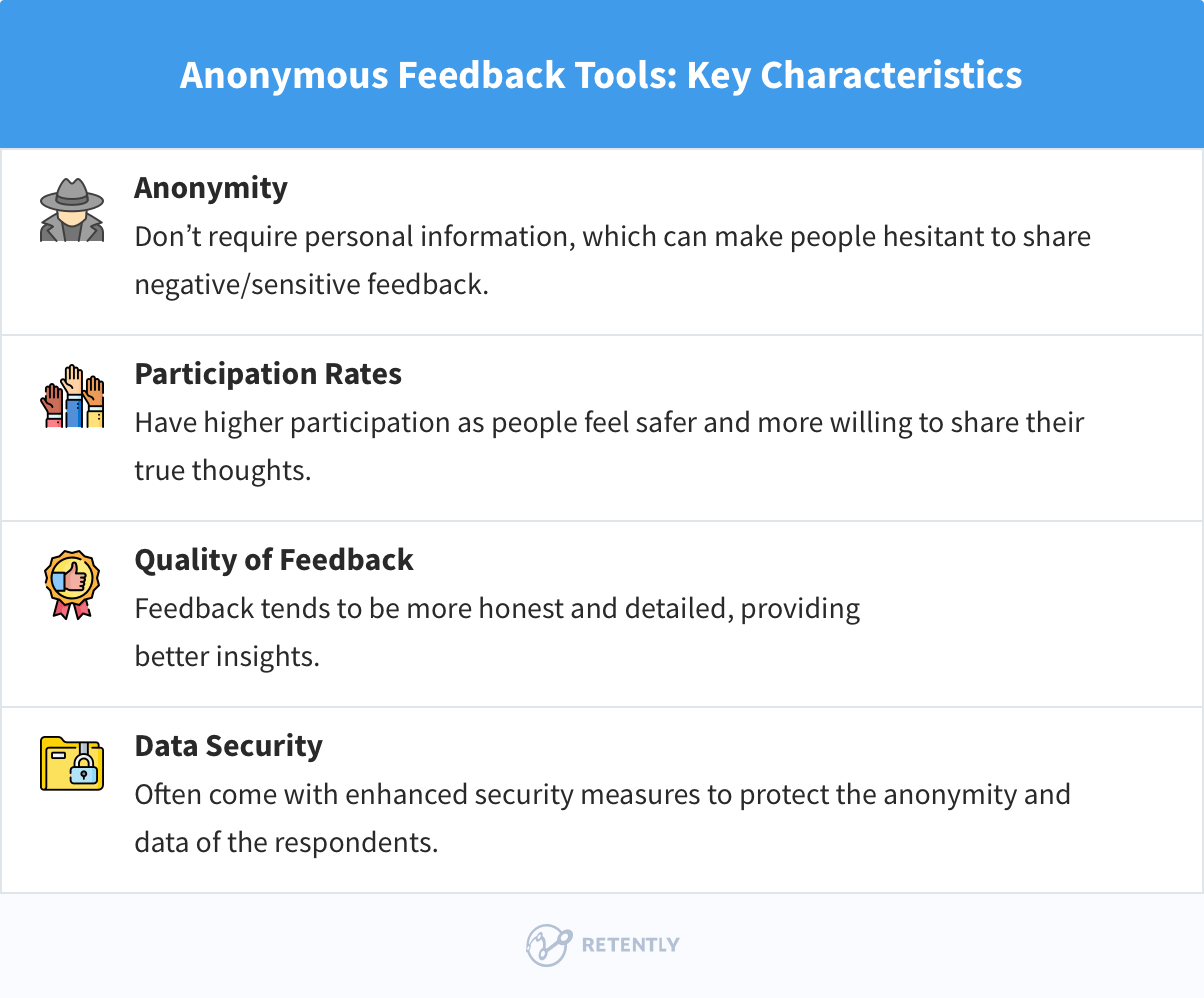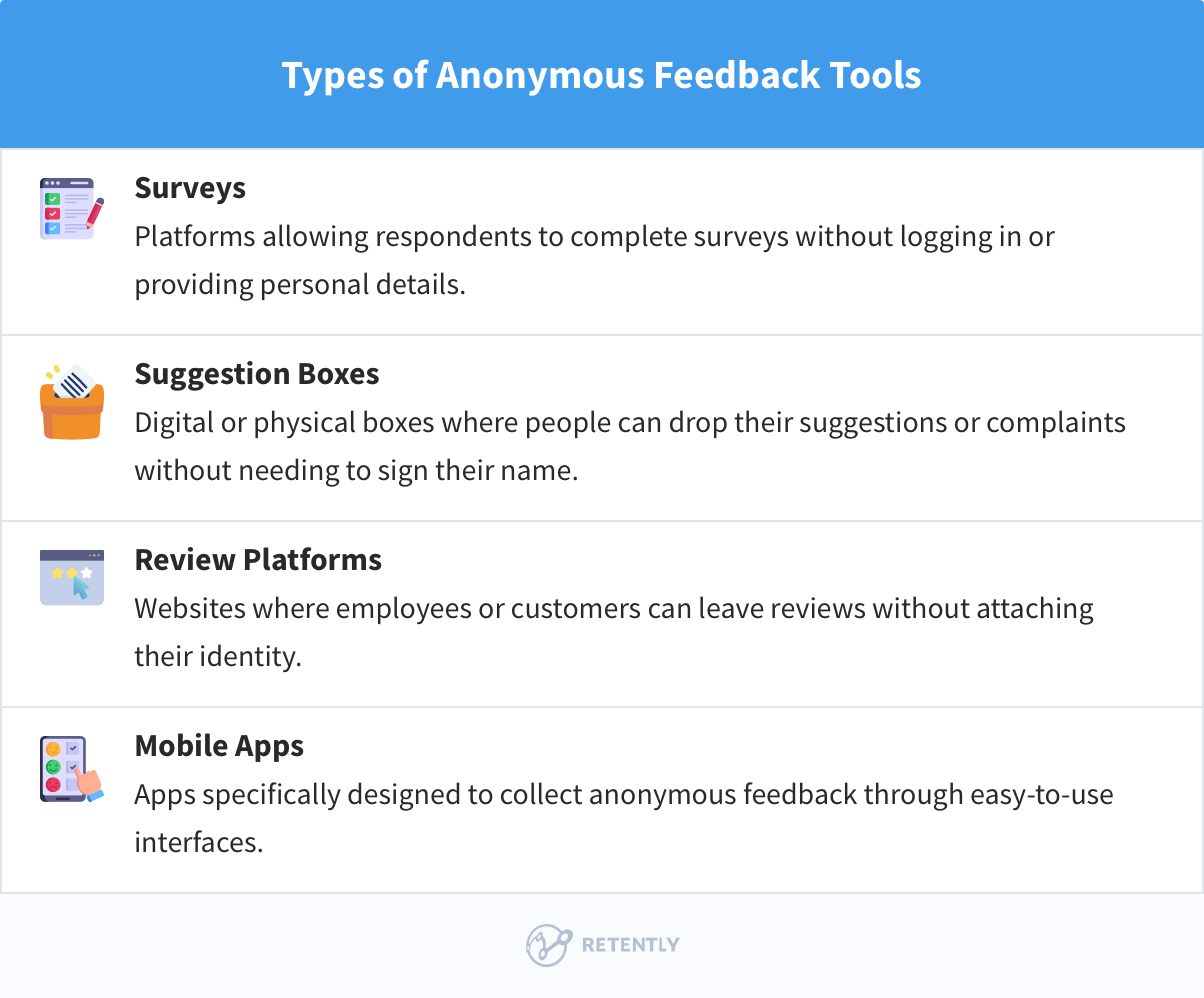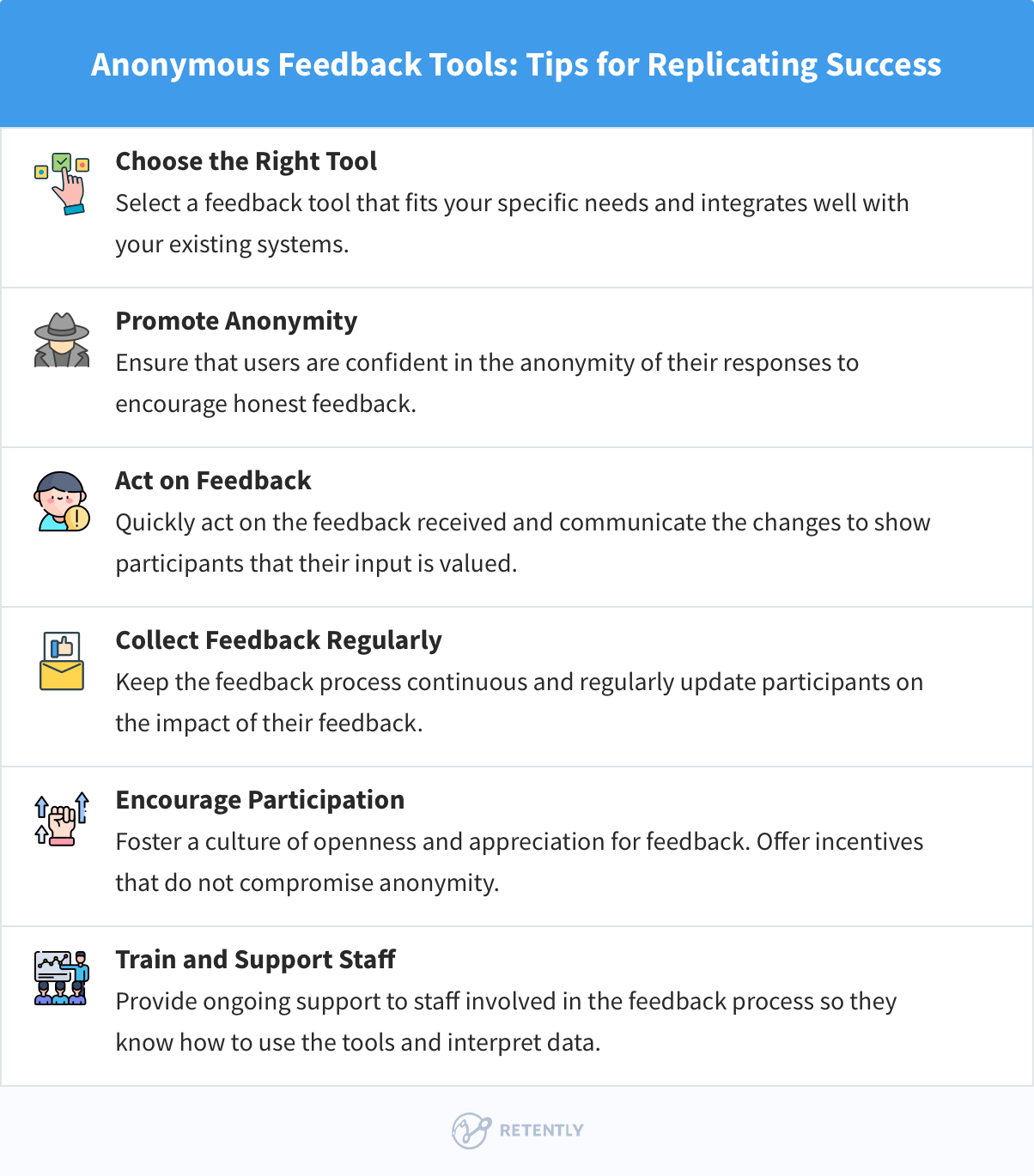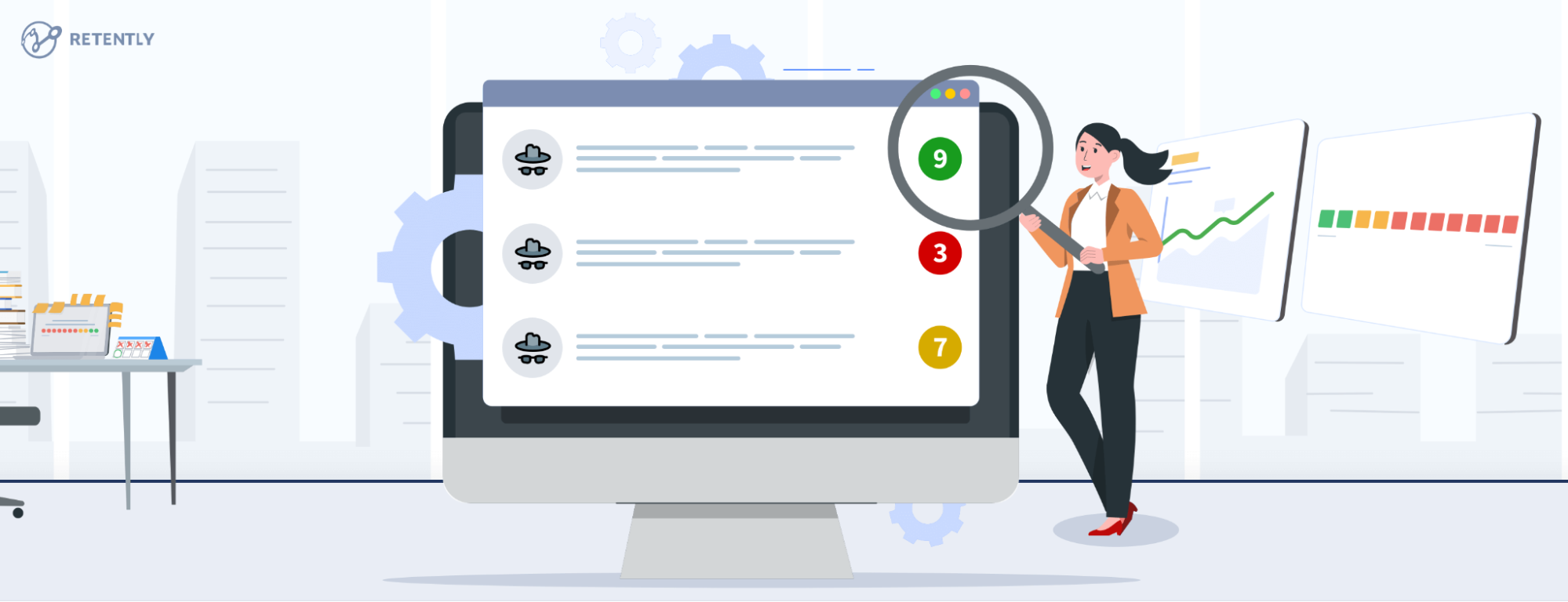When the goal is to extract genuine feedback without compromising privacy, the challenge lies in finding the appropriate anonymous feedback tool. This piece cuts to the chase, offering insights on how to identify and implement these tools effectively, striking a balance between confidentiality, ease of use, and integration – all while keeping costs in mind.
Key Takeaways
- Anonymous feedback tools ensure open, safe, and honest communication, increasing the likelihood of receiving genuine insights from employees and customers alike.
- Integrating anonymous feedback into business strategy helps identify trends, informs policy changes, and facilitates continuous growth and improvement within companies.
- Leveraging anonymous feedback tools can be a cost-effective way for businesses to achieve a more open, communicative environment.
Why Honest Feedback Matters?
Why do some businesses seem to have a magical touch with their customers while others struggle? A big part of the secret sauce is honest feedback. Imagine trying to improve your cooking without ever tasting your food or hearing what others think about it. That’s what running a business without genuine feedback is like.
Honest feedback is like a roadmap for businesses. It tells them what they’re doing right, what needs fixing, and where they can innovate. Whether it’s a new product launch, a customer service experience, or internal processes, knowing what people really think helps businesses grow and thrive. It’s the difference between guessing and knowing.
But let’s face it: getting people to be completely honest isn’t always easy. People often sugarcoat their opinions to avoid hurting feelings or dodge any potential backlash. This is where the challenge lies.
Challenges of Obtaining Genuine Feedback
There are a few hurdles to collecting honest feedback. First, there’s the fear factor. People might worry about the consequences of being brutally honest, especially if it’s negative feedback. This fear can lead to vague or overly positive responses that don’t really help anyone.
Then, there’s the effort involved. Giving detailed feedback takes time and energy; not everyone is willing to invest in that. Plus, people are even less likely to participate if the feedback process is complicated or lengthy.
Here’s where anonymity comes into play. When feedback is anonymous, people feel safe and more inclined to speak their minds. It’s like having a heart-to-heart with a friend where you can say anything without being judged.
When people know their names aren’t attached to their comments, they’re more likely to share their thoughts. This can be a game-changer for businesses. Anonymity removes the fear of repercussions, allowing employees, customers, and clients to be candid about their experiences and opinions.
Benefits of Anonymous Feedback
Psychologically, anonymity reduces the pressure to conform to social norms or expectations. People feel free to express their genuine thoughts and feelings. This leads to more authentic, actionable feedback that businesses can use to make real improvements.
Practically, anonymous feedback tools are often easy to use and can be integrated into existing systems with minimal hassle. This means businesses can collect a wealth of honest feedback regularly without disrupting their everyday operations.
Essentially, anonymous feedback tools open up a world of valuable insights. By ensuring that feedback is both safe and straightforward to give, businesses can get the real scoop on what’s working and what’s not, helping them make better decisions and fostering a culture of continuous improvement.
Understanding Anonymous Feedback Tools
So, what exactly are they? Let’s dive into what anonymous feedback tools are all about.
Simply put, anonymous feedback tools are platforms or systems that allow people to share their opinions, suggestions, and criticisms without revealing their identity. Businesses, schools, organizations, and even governments can use these tools to gather honest feedback from their customers, employees, students, or citizens.
How They Differ from Traditional Feedback Mechanisms
Now, you might be wondering how these tools are different from traditional feedback methods. Let’s break it down:
- Anonymity: Traditional feedback mechanisms often require personal information, which can make people hesitant to share negative or sensitive feedback. For example, a feedback form might ask for your name, email, or employee ID, which can lead to guarded responses. Anonymous feedback tools remove this barrier.
- Participation Rates: With traditional methods, people might avoid giving feedback due to fear of repercussions or simply because it’s too time-consuming. Anonymous tools have higher participation as people feel safer and more willing to share their true thoughts.
- Quality of Feedback: Feedback provided by anonymous tools tends to be more honest and detailed, providing better insights.
- Data Security: With traditional methods, there is a risk of data breaches if personal information is mishandled. Anonymous tools often come with enhanced security measures to protect the anonymity and data of the respondents.
Therefore, anonymous feedback tools are designed to overcome the barriers associated with traditional feedback methods. They make it easier for people to be truthful, leading to more reliable and actionable insights. By leveraging these tools, you can tap into insights that might otherwise be inaccessible.

Types of Anonymous Feedback Tools
To get more people involved through anonymous feedback, it’s essential to offer various options to suit different preferences. By using different methods like online surveys and conversational AI, you give everyone plenty of chances to share their thoughts and feel appreciated for their input.
There are several types of anonymous feedback tools that you can use to gather honest insights. Let’s take a look at some of the most popular ones:
1. Surveys
Surveys are one of the most common anonymous feedback tools. They can be distributed online or in paper form and are designed to collect specific information from a large number of people. Online survey tools like Google Forms or specialized survey software like Retently, allow you to create anonymous surveys easily. Specialized tools are highly customizable, allowing you to personalize everything from branding and question styles to specific survey types like NPS or CSAT, tailored to your organization’s needs.
- Pros: Easy to distribute, can reach a large audience, customizable survey templates, various question types (multiple choice, open-ended, scales, etc.)
- Cons: May have low response rates if not well-designed or promoted.
2. Suggestion Boxes
Suggestion boxes, whether physical or digital, provide a simple way for people to submit their ideas and feedback anonymously. Digital tools allow the customization of suggestion forms to fit specific needs. These are often used in workplaces, schools, and public spaces.
- Pros: Simple to set up, encourages ongoing feedback.
- Cons: It can be overlooked or forgotten, and may require manual sorting and analysis.
3. Online Review Platforms
Websites like Trustpilot allow users to leave anonymous reviews about companies, products, and services. These reviews significantly influence potential customers’ decisions, impacting a company’s reputation and sales. However, these are not limited to customers only. For example, Glassdoor increases company transparency by providing honest, unfiltered employee experiences. Employers receive ratings based on various criteria, which can attract or deter potential talent. These platforms are handy for gathering feedback on a larger scale.
- Pros: Wide reach, trusted by users, might feature built-in analytics.
- Cons: Can attract overly negative reviews, and it is harder to verify the authenticity of reviews.
4. Mobile Applications
There are various mobile apps designed for anonymous feedback, such as Whisper for general feedback, and workplace-specific tools. These apps are convenient and accessible, making it easy for users to share their thoughts on the go.
- Pros: Highly accessible, real-time feedback, often featuring interactive elements.
- Cons: Requires user buy-in to download and use the app, privacy concerns if not well-secured.

5. Interactive Chatbots
Interactive chatbots have changed the game for collecting anonymous feedback by making it happen in real time. These bots, integrated into communication platforms, give an easy and private channel to share thoughts right when they have them. This mix of convenience and privacy creates an environment where feedback isn’t just collected – it’s something everyone looks forward to giving.
Leveraging these anonymous feedback tools allows businesses and organizations to tap into a wealth of actionable insights. This helps improve products and services and fosters a culture of transparency and continuous improvement.
Implementing Anonymous Feedback Tools
When selecting an anonymous feedback tool, the first step is clearly defining your objectives. Understanding why you need the tool and what you hope to achieve with it is essential. Are you aiming to improve customer satisfaction, enhance employee engagement, or refine product development? Knowing your purpose will guide your decision-making process.
Next, consider your audience. Who will be providing feedback? The tool should be user-friendly for your target group, whether they are customers, employees or stakeholders. Features are another critical factor. Look for tools that offer the functionalities you need, such as customizable surveys, real-time analytics, robust security measures, and seamless integration capabilities.
Budget is also an important consideration. Ensure the tool fits within your financial constraints, taking into account both initial setup costs and ongoing maintenance expenses. Comparing different tools involves looking at user reviews, reading case studies, and understanding how other organizations have benefited from them. Taking advantage of free trials and demos can provide firsthand experience with the tools, helping you to make an informed decision. Additionally, consider the level of customer support and training provided by the vendor, as good support can significantly ease the implementation process.
Here’s a quick checklist to consider that we will further elaborate for a more informed decision:
Checklist: Choosing the Right Anonymous Feedback Tool
When choosing an anonymous feedback tool, make sure to go through these main factors:
- User Interface: A clean, intuitive interface is crucial. If the tool is clunky or complicated, people will likely not use it. Look for something with a user-friendly design that makes giving feedback a breeze.
- Privacy Features: Since we’re talking about anonymous feedback, robust privacy features are non-negotiable. Ensure that the tool truly anonymizes responses and that data is stored securely.
- Scalability: Can the tool grow with you? Whether you’re a small startup or a large enterprise, consider how well the tool can handle increasing amounts of feedback as your company grows.
- Integration Capabilities: Check if the tool integrates smoothly with other software you use. For example, can it sync with your HR management system, your customer relationship management platform, or your project management tools?
- Analytics and Reporting: Look for powerful analytics capabilities and detailed reporting features to make sense of the data.
Key Features of Effective Anonymous Feedback Tools
To ensure the effectiveness of anonymous feedback tools, it’s important for them to possess several key features, including:
-
Anonymity Assurance
One of the most critical features of effective anonymous feedback tools is their ability to guarantee user anonymity. This can be achieved in several ways. Firstly, using robust data encryption for both data in transit and at rest protects user information from being intercepted or accessed by unauthorized parties. Additionally, these tools should avoid collecting personal identifiers like names, emails, or IP addresses to ensure the feedback stays anonymous. Another method involves using anonymous authentication, such as tokens or codes, which verify participation without revealing user identities. Moreover, effective tools report feedback in aggregate form, preventing the tracing of responses back to individual users.
Legal and ethical considerations are also key in maintaining anonymity. Tools must comply with data protection regulations like GDPR to ensure legal compliance. They should clearly communicate their privacy policies and data handling practices to users, ensuring they understand how their data will be used and protected. Obtaining clear and informed consent from users about data usage is essential.
-
User-Friendly Interface
Any feedback tool must have an intuitive and user-friendly interface to be effective. A well-designed interface simplifies navigation and reduces the need for extensive instructions, making it easier for users to provide feedback. This ease of use increases participation rates, as users are more likely to engage with a tool that is simple and straightforward. Additionally, a positive user experience fosters a willingness to provide feedback again in the future, ensuring a reliable data flow.
Several tools exemplify user-friendly design. Retently, for example, offers a clean and easy-to-navigate interface with customizable surveys paired with smart automation features. Google Forms is known for its simplicity, real-time collaboration features, and seamless integration with other Google services. Typeform stands out with its conversational design and interactive features. Slido provides real-time event interaction capabilities, allowing easy access via web links or QR codes. Mentimeter combines interactive presentations with real-time polling and a user-friendly design.
-
Data Security
This involves using robust encryption methods, implementing role-based access control to limit data access to authorized personnel, and conducting regular security assessments to identify and mitigate potential risks. Techniques like data masking and tokenization help protect user identities by anonymizing data before storage. Secure storage solutions, such as compliant data centers with advanced security measures, add an additional layer of protection. A robust incident response plan is also important for handling data breaches and security incidents promptly and effectively.
-
Customization and Flexibility
Effective feedback tools offer high levels of customization and flexibility to meet various needs and contexts. Customizable surveys and feedback forms allow users to design questions specific to their needs, using various question types and branching logic. This ensures that the feedback collected is relevant and actionable. Tools should also allow for customization of the look and feel to align with the brand, enhancing the user experience.
Flexibility in feedback collection methods is also important. Tools should support multi-channel distribution, allowing surveys to be shared via email, web links, QR codes, in-app, and on-site. Real-time feedback collection during events or through mobile apps ensures timely and relevant data. Anonymous channels such as surveys, suggestion boxes, and confidential interviews help maintain anonymity while collecting detailed feedback.
Moreover, your chosen tool should grow with your organization. What works for a small team may not work for a large enterprise. What to look for? Options for different organizational sizes, flexible pricing plans, and the ability to handle increasing amounts of data and users.
-
Integration Capabilities
For a feedback tool to be effective, it must integrate seamlessly with your existing systems. Compatibility is key – make sure the tool works well with your current CRM, HR software, or data analytics platforms. Many tools offer APIs or built-in integrations that facilitate this process. Plan how data from the feedback tool will flow into your existing systems, ensuring that it can be easily managed and analyzed. This integration helps create a cohesive feedback ecosystem where data is accessible and actionable.
-
Analytics and Reporting
Robust analytics and comprehensive reporting features are key for turning raw feedback into meaningful insights. Effective analytics help identify trends and patterns within the input, revealing recurring issues and popular suggestions. This allows organizations to prioritize actions based on the potential impact and urgency of the feedback. Segmenting data by demographics, location, or specific user groups helps understand different perspectives and needs.
It is also important to measure the success of changes implemented based on feedback. By comparing pre- and post-implementation data, organizations can assess the effectiveness of their actions and demonstrate improvements.
Anonymous Feedback: Tips for Replicating Success
By following these best practices and learning from successful implementations, businesses can effectively leverage anonymous feedback tools to drive significant improvements in employee engagement, customer satisfaction, and overall operational efficiency:
- Choose the Right Tool: Select a feedback tool that fits your specific needs and integrates well with your existing systems. What’s more, an engaging and user-friendly interface can increase participation and improve the quality of responses.
- Promote Anonymity: To encourage honest feedback, ensure that users are confident in the anonymity of their responses. Clearly communicate how anonymity is maintained and the steps taken to protect respondents’ identities.
- Act on Feedback: Quickly act on the feedback received and communicate the changes to show participants that their input is valued.
- Regular Feedback Collection and Updates: Keep the feedback process continuous and regularly update participants on the impact of their feedback. Quarterly or bi-annual surveys can help keep a pulse on customer and employee sentiment.
- Encourage Participation: Foster a culture of openness and appreciation for feedback. Offer incentives that do not compromise anonymity to boost participation.
- Train and Support Staff: Provide training and ongoing support to staff involved in the feedback process. Ensuring they understand how to use the tools and interpret the data is essential for success.

Conclusion
As we wrap things up, remember that the real strength of anonymous feedback is its ability to reveal the honest truth. By choosing the right tools, thoughtfully designing surveys, and responding positively to the feedback you get, you can use this honesty to fuel growth and innovation in your company.
If you haven’t already, consider integrating anonymous feedback tools into your organizational processes. Choose a tool that aligns with your needs, ensure its features meet your requirements, and commit to using the feedback you collect to make tangible changes. Doing so will enhance your decision-making capabilities while strengthening your relationships with employees, customers, and stakeholders.
Embrace the journey of continuous improvement through anonymous feedback with Retently. Retently offers customizable surveys, allowing users to create tailored surveys with various question types and branching logic. The intuitive design makes it easy for respondents to complete surveys, and the tool provides robust analytics and detailed reporting features – including custom reports, benchmarking, sentiment analysis, and interactive visualizations – to effectively analyze survey results. Additionally, Retently integrates with numerous third-party applications like CRM and marketing tools.
Start your free trial and take the path to a more transparent, engaged, and successful future.





























 Alex Bitca
Alex Bitca 


 Greg Raileanu
Greg Raileanu 
 Christina Sol
Christina Sol 
